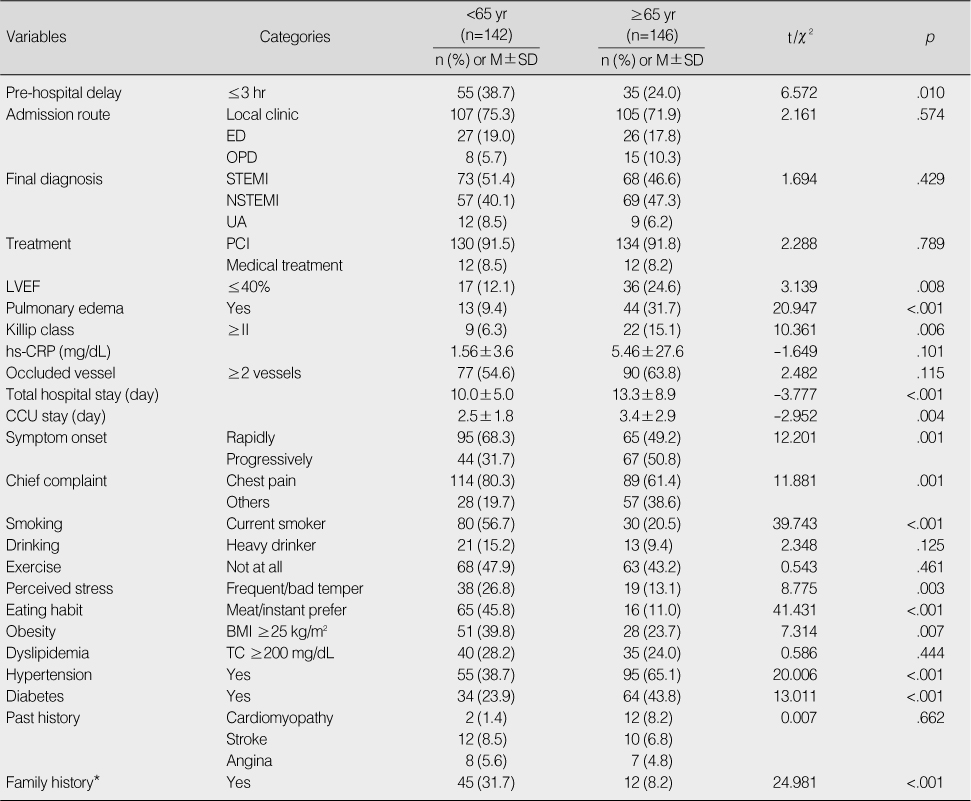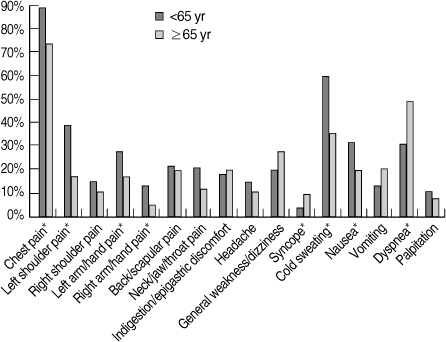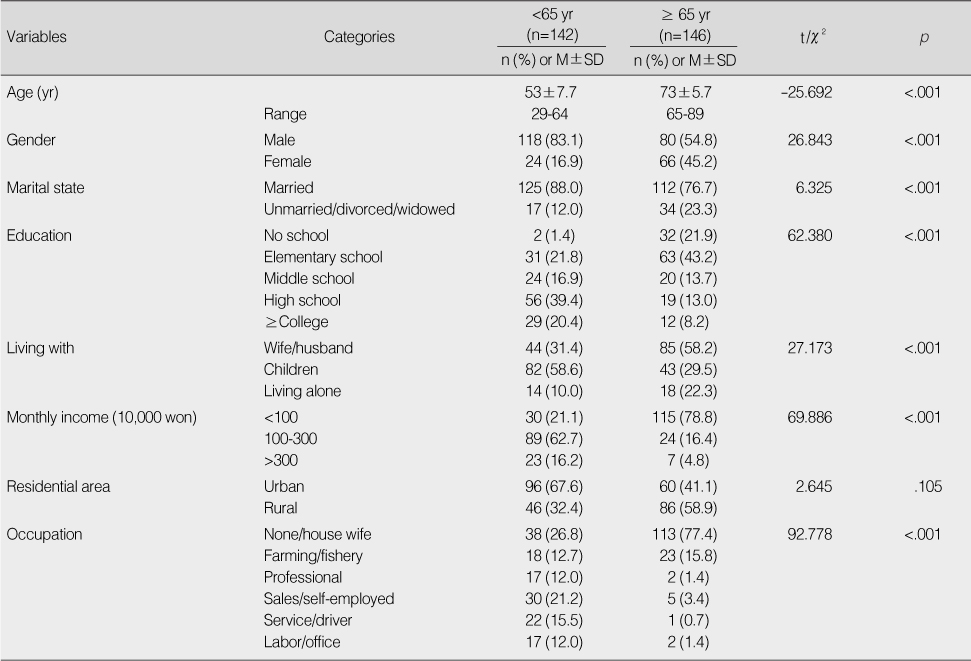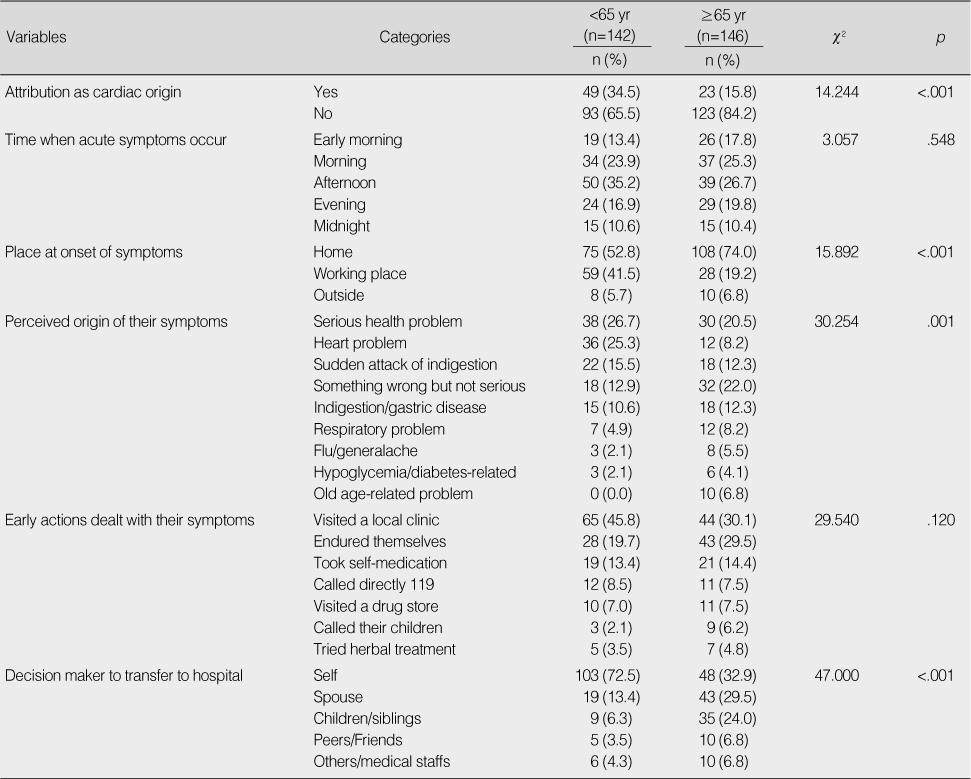Articles
- Page Path
- HOME > J Korean Acad Nurs > Volume 39(6); 2009 > Article
-
Original Article
- Comparison of Clinical Manifestations and Treatment-Seeking Behavior in Younger and Older Patients with First-time Acute Coronary Syndrome
- Seon Young Hwang
-
Journal of Korean Academy of Nursing 2009;39(6):888-898.
DOI: https://doi.org/10.4040/jkan.2009.39.6.888
Published online: December 31, 2009
Assistant Professor, Department of Nursing, Chosun University, Gwangju, Korea.
- Address reprint requests to: Hwang, Seon Young. Department of Nursing, Chosun University, 375 Seoseok-dong, Dong-gu, Gwangju 501-759, Korea. Tel: 82-62-230-7637, Fax: 82-62-230-6329, seon9772@chosun.ac.kr
Copyright © 2009 Korean Society of Nursing Science
Abstract
-
Purpose
- This study was conducted to examine and compare clinical manifestations and predicting factors for treatment-seeking delay among patients <65 and ≥65 yr with first-time acute coronary syndrome (ACS).
-
Methods
- A total of 288 patients who were diagnosed with ACS were individually interviewed at C university hospital in G-city from November 2007 to December 2008.
-
Results
- Median pre-hospital delays for younger and older patients were 5 and 12 hr, respectively. Younger patients were more likely to be current smokers, heavy drinkers, obese, stressed, and have an unhealthy diet and family history, and to complain of chest pain, left shoulder and arm pain, perspiration, and nausea. Older patients were more likely to have hypertension and diabetes, and to complain syncope and dyspnea. Logistic regression analyses showed that after adjustment for age, gender and education, progressive onset of symptom and no attribution to cardiac problem significantly predicted pre-hospital delay >3 hr in both younger and older patients. Low perceived health status was a significant independent predictor in older patients only.
-
Conclusion
- Health care providers should be concerned with different manifestations between younger and older adults, and educate people at risk for heart attack about symptoms and actions to get immediate help.
- 1. An KE, Koh BG. Pre- and in-hospital delay in treatment and in-hospital mortality after acute myocardial infarction. Journal of Korean Academy of Nursing. 2003;33:1153–1160.ArticlePubMedPDF
- 2. Antman EM, Anbe DT, Armstrong PW, Bates ER, Green LA, Hand M, et al. ACC/AHA guidelines for the management of patients with ST-elevation myocardial infarction: A report of the American College of Cardiology/American Heart Association task force on practice guidelines (Committee to revise the 1999 guidelines for the management of patients with acute myocardial infarction). Circulation. 2005;111:2013–2014.
- 3. Arslanian-Engoren C, Patel A, Fang J, Armstrong D, Kline-Rogers E, Duvernoy CS, et al. Symptoms of men and women presenting with acute coronary syndromes. American Journal of Cardiology. 2006;98:1177–1181.ArticlePubMed
- 4. Berger PB, Ellis SG, Holmes DR Jr, Criger DA, Granger CB, Betriu A, et al. Relationship between delay in performing direct coronary angioplasty and early clinical outcome in patients with acute myocardial infarction: Results from the global use of strategies to open occluded arteries in acute coronary syndromes (GUSTO-IIb) trial. Circulation. 1999;100:14–20.ArticlePubMed
- 5. Brieger D, Eagle KA, Goodman SG, Steg PG, Budaj A, White K, et al. Acute coronary syndromes without chest pain, an underdiagnosed and under treated high-risk group: Insights from the global registry of acute coronary events. Chest. 2004;126:461–469.ArticlePubMed
- 6. Canto JG, Shlipak MG, Rogers WJ, Malmgren JA, Frederick PD, Lambrew CT, et al. Prevalence, clinical characteristics, and mortality among patients with myocardialinfarction presenting without chest pain. JAMA. 2000;283:3223–3229.ArticlePubMed
- 7. Dracup K, Moser DK. Beyond sociodemographics: Factors influencing the decision to seek treatment for symptoms of acute myocardial infarction. Heart & Lung. 1997;26:253–262.Article
- 8. Dracup K, Moser DK, McKinley S, Ball C, Yamasaki K, Kim CJ, et al. An international perspective on the time to treatment for acute myocardial infarction. Journal of Nursing Scholarship. 2003;35:317–323.ArticlePubMed
- 9. Eom WS, Kim DK, Kim YJ, Ryu JS, Cho JH, Joo SB, et al. The first symptoms and diagnosis of acute coronary syndrome in elderly patients of Korea. Geriatric Disease. 2003;7:313–320.
- 10. Franklin K, Goldberg RJ, Spencer F, Klein W, Budaj A, Brieger D, et al. Implications of diabetes in patients with acute coronary syndromes. Archives of Internal Medicine. 2004;164:1457–1463.PubMed
- 11. Goldberg RJ, Mooradd M, Gurwitz JH, Rogers WJ, French WJ, Barron HV, et al. Impact of time to treatment with tissue plasminogen activator on morbidity and mortality following acute myocardial infarction (the second National Registry of Myocardial Infarction). American Journal of Cardiology. 1998;82:259–264.ArticlePubMed
- 12. Goldberg RJ, Steg PG, Sadiq I, Granger CB, Jackson EA, Budaj A, et al. Extent of, and factors associated with, delay to hospital presentation in patients with acute coronary disease (the GRACE registry). American Journal of Cardiology. 2002;89:791–796.ArticlePubMed
- 13. Gregoratos G. Clinical manifestations of acute myocardial infarction in older patients. American Journal of Geriatric Cardiology. 2001;10:345–347.ArticlePubMedPDF
- 14. Hwang SY, Park EH, Shin ES, Jeong MH. Comparison of factors associated with atypical symptoms among older and younger patients with acute coronary syndromes. Journal of Korean Medical Science. 2009;24:789–794.PubMedPMC
- 15. Jeong MH, Kim YJ, Kim CJ, Cho MC, An YK, Na SW, et al. Korean acute myocardial infarction registry. Korean Circulation Journal. 2007;37(10):Supplement. 3–18.
- 16. Korea National Health Insurance Corporation. National health insurance statistical yearbook 2006. 2007;12;Seoul, Author.
- 17. Classification of disease and causes of death 2007. Korea National Statistical Office. 2007;12 01 Retrieved October 8, 2008. from http://Kosis.kr.
- 18. Løvlien M, Schei B, Hole T. Prehospital delay, contributing aspects and responses to symptoms among Norwegian women and men with first time acute myocardial infarction. European Journal of Cardiovascular Nursing. 2007;6:308–313.ArticlePubMedPDF
- 19. Milner KA, Funk M, Richards S, Vacarrino V, Krumholz HM. Symptom predictors of acute coronary syndromes in younger and older patients. Nursing Research. 2001;50:233–241.ArticlePubMed
- 20. Moser DK, An KA. Responses to symptoms of acute myocardial infarction: Reasons for delay and bystanders' role. Journal of Korean Academy of Nursing. 2002;32:1063–1071.ArticlePDF
- 21. Moser DK, Kimble LP, Alberts MJ, Alonzo A, Croft JB, Dracup K, et al. Reducing delay in seeking treatment by patients with acute coronary syndrome and stroke: A scientific statement from the American Heart Association Council on cardiovascular nursing and stroke council. Circulation. 2006;114:168–182.ArticlePubMed
- 22. Oh HS, Jang KS, Jeong MH. Decision tree model of treatment-seeking delay among patients with acute coronary syndrome. Korean Journal of Health Promotion and Disease Prevention. 2008;8:235–244.
- 23. Ottesen MM, Kober L, Jorgensen S, Torp-Pedersen C. Determinants of delay between symptoms and hospital admission in 5,978 patients with acute myocardial infarction. European Heart Journal. 1996;17:429–437.ArticlePubMed
- 24. Schuler J, Meier B, Behrens S, Thimme W. Present treatment of acute myocardial infarction in patients over 75 years, data from the Berlin myocardial infarction registry. Clinical Research in Cardiology. 2006;95:360–367.PubMed
- 25. Song YB, Hahn JY, Gwon HC, Kim JH, Lee SH, Jeong MH, et al. The impact of initial treatment delay using primary angioplasty on mortality among patients with acute myocardial infarction: From the Korea acute myocardial infarction registry. Journal of Korean Medical Science. 2008;23:357–364.ArticlePubMedPMC
- 26. Tespili M, Guagliumi G, Valsecchi O, Musumeci G, Vassileva A, Saino A, et al. In-hospital clinical outcome in elderly patients with acute myocardial infarction treated with primary angioplasty. Italian Heart Journal. 2003;4:193–198.PubMed
- 27. Thuresson M, Berglin M, Lindahl B, Svensson L, Zedigh C, Herlitz J. Thoughts, actions, and factors associated with prehospital delay in patients with acute coronary syndrome. Heart & Lung. 2007;36:398–409.Article
- 28. Zerwic JJ. Patient delay in seeking treatment for acute myocardial infarction symptoms. Journal of Cardiovascular Nursing. 1999;13:21–32.ArticlePubMed
REFERENCES

*Family history included the histories of hypertension, heart disease or stroke in their parents or siblings.
ED=emergency department; OPD=out patient department; STEMI=ST-elevation myocardial infarction; NSTEMI=non-ST-elevation myocardial infarction; UA=unstable angina; PCI=percutaneous coronary intervention; LVEF=left ventricular ejection fraction; CABG=coronary artery bypass graft; hs-CRP=high sensitivity-C reactive protein; CCU=coronary care unit; BMI=body mass index; TC=total cholesterol.
Figure & Data
REFERENCES
Citations

- Anti-inflammatory effects of rosuvastatin treatment on coronary artery ectasia patients of different age groups
Cheng-Hui Fan, Ying Hao, Yong-Hua Liu, Xiao-Lin Li, Zhen-Hao Huang, Yu Luo, Rui-Lin Li
BMC Cardiovascular Disorders.2020;[Epub] CrossRef - Knowledge on Cardio-cerebrovascular Disease and Health Behaviors among Middle-aged Postmenopausal Women at Risk
Kyung Ae Kim, Seon Young Hwang
Korean Journal of Adult Nursing.2016; 28(4): 424. CrossRef - Gender Differences in Delay Seeking Treatment and Related Experiences in Patients with Acute Myocardial Infarction
Mi-Suk Won, Nah-Mee Shin, Eunsook Kim
Korean Journal of Adult Nursing.2016; 28(4): 459. CrossRef - Cluster dyads of risk factors and symptoms are associated with major adverse cardiac events in patients with acute myocardial infarction
Seon Young Hwang, JinShil Kim
International Journal of Nursing Practice.2015; 21(2): 166. CrossRef - Symptom Clusters in Korean Patients with Acute Myocardial Infarction
Eunjin Park, Jia Lee
Journal of Korean Academy of Nursing.2015; 45(3): 378. CrossRef - Lifestyle Differences between Middle-aged and Old-aged Patients with Acute Myocardial Infarction
김미정, 김계하
Health and Social Welfare Review.2012; 32(1): 260. CrossRef - Atypical Symptom Cluster Predicts a Higher Mortality in Patients With First-Time Acute Myocardial Infarction
Seon Young Hwang, Young Geun Ahn, Myung Ho Jeong
Korean Circulation Journal.2012; 42(1): 16. CrossRef - Impact of Prodromal Symptoms on Prehospital Delay in Patients With First-Time Acute Myocardial Infarction in Korea
Seon Young Hwang, Julie J. Zerwic, Myung Ho Jeong
Journal of Cardiovascular Nursing.2011; 26(3): 194. CrossRef

Figure 1
General Characteristics of the Subjects (N=288)
Clinical Characteristics and Risk Factors of the Subjects (N=288)
*Family history included the histories of hypertension, heart disease or stroke in their parents or siblings.
ED=emergency department; OPD=out patient department; STEMI=ST-elevation myocardial infarction; NSTEMI=non-ST-elevation myocardial infarction; UA=unstable angina; PCI=percutaneous coronary intervention; LVEF=left ventricular ejection fraction; CABG=coronary artery bypass graft; hs-CRP=high sensitivity-C reactive protein; CCU=coronary care unit; BMI=body mass index; TC=total cholesterol.
Cognitive and Behavioral Responses to Symptoms of the Subjects
Predictors of Pre-hospital Delay >3 hr in Younger and Older Subjects by Multiple Logistic Regression Analyses
*Adjusted variables: age, gender and education level.
CI=confidence interval; NSTEMI=non-ST-elevation myocardial infarction; UA=unstable angina.
*Family history included the histories of hypertension, heart disease or stroke in their parents or siblings. ED=emergency department; OPD=out patient department; STEMI=ST-elevation myocardial infarction; NSTEMI=non-ST-elevation myocardial infarction; UA=unstable angina; PCI=percutaneous coronary intervention; LVEF=left ventricular ejection fraction; CABG=coronary artery bypass graft; hs-CRP=high sensitivity-C reactive protein; CCU=coronary care unit; BMI=body mass index; TC=total cholesterol.
*Adjusted variables: age, gender and education level. CI=confidence interval; NSTEMI=non-ST-elevation myocardial infarction; UA=unstable angina.
 KSNS
KSNS
 E-SUBMISSION
E-SUBMISSION




 Cite
Cite

